The next-generation Volkswagen Tiguan won't arrive in the United States until the summer of 2017. That's over a year from now, despite the new Tig's unveiling at the Frankfurt Motor Show in September 2015. Europeans will be able to pick up their new Tiguans in April of this year. So in an effort to show us some of what's in store for this important new model, Volkswagen flew us to Arvidsjaur, Sweden for a closer look at the totally new Tiguan.
Ten bucks says you (probably) can't pick out Arvidsjaur on a map. But if you're a car buff – and Autoblog reader – you've undoubtedly seen pictures of this place without even knowing it. All those spy shots of European test mules and prototypes in the snow? Most of them are from in and around Arvidsjaur. Many car companies have winter driving schools up here – Volkswagen included. So despite the bitterly cold temperatures, this tiny town in northern Sweden is a hotbed for wintertime development. And since a big feature of the new Tiguan is its improved 4Motion all-wheel-drive system with an Active Control function, what better place to get a sense of its snow prowess than the very place where these systems are developed?
Now, because the US-spec Tiguan is so far away, the car we drove is extremely dissimilar to the final product that will end up on our shores. So rather than just tell you what the not-for-US Tiguan is like to drive, we're instead bringing you some details of what to expect for our upcoming new model, with the snowy roads of Sweden as a backdrop and some Euro-spec impressions spliced in. It may be over a year away, but we've got a good idea of what to expect for America's next Tiguan.

Our version will be longer, with an optional third row of seats.
Like the looks of the Tiguan pictured here? Well, don't get too attached. The US-spec model will be longer, riding on a stretched wheelbase – final dimensions are still being confirmed. Volkswagen isn't just making our Tiguan longer for no good reason. In an effort to maximize versatility and functionality, the Tiguan will be offered with three rows of seats in the US. That said, way-back seating will be an option, so if you'd rather just have a Tiguan with a huge cargo area, Volkswagen will happily sell you one. Euro-spec Tiguans offer 58.5 cubic feet of space with the rear seats folded, and the US market car will be even more capacious.
The long-wheelbase, three-row model will be sold in Europe along the shorter, five-passenger model you see here. Plus, the car pictured here has the European "off-road" front end treatment, something we won't be getting in the States. Instead, expect our Tiguan to have a more squared-off fascia appearance, similar to what we saw in Frankfurt last year. As for the possibility of getting either the short-wheelbase Tiguan or its rugged front fascia in the States, Volkswagen says neither is likely.
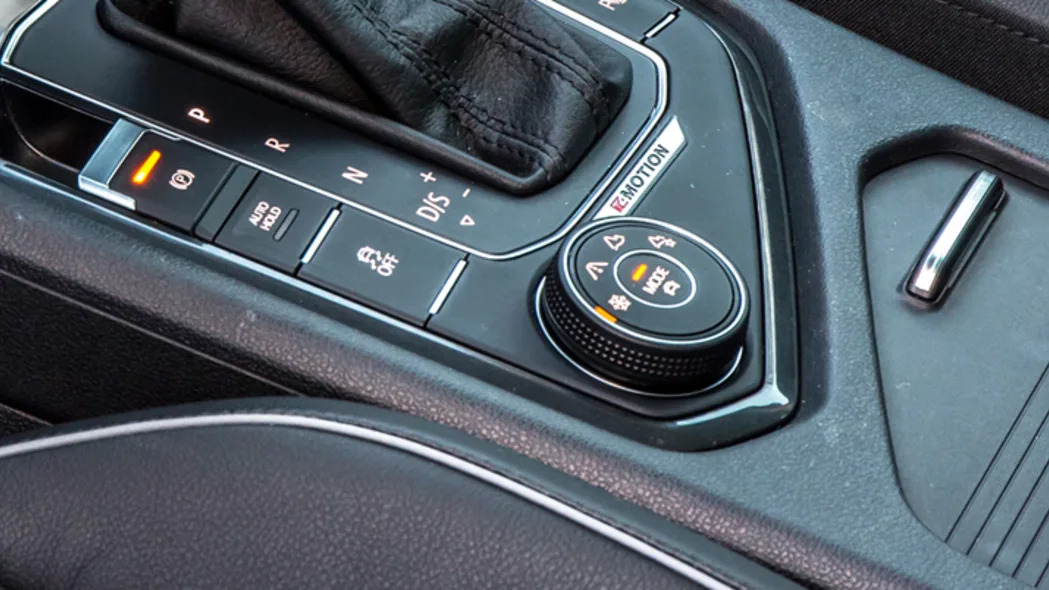
There's a new 4Motion Active Control system.
4Motion all-wheel drive isn't new, but it gets a few new tricks in the Tiguan. Since it rides on the same versatile MQB architecture as the Golf, the Tiguan gets the same fifth-generation, multi-plate-clutched Haldex system as the Golf R. This means when all-wheel-drive power isn't needed, the rear axle can be decoupled for better efficiency. But that's old news in Volkswagen's world. What's brand-new for the Tiguan is something called 4Motion Active Control, with a rotary dial on the center console, just behind the gear lever, that lets drivers toggle between different drive modes.
Active Control isn't a new concept – think of it as a less-robust version of Land Rover's Terrain Management system. All 4Motion-equipped Tiguans will get this – you can switch between Onroad, Snow, Offroad, and Offroad Individual settings, which alter the different drive systems for better performance in different conditions. We'll go into more detail shortly.
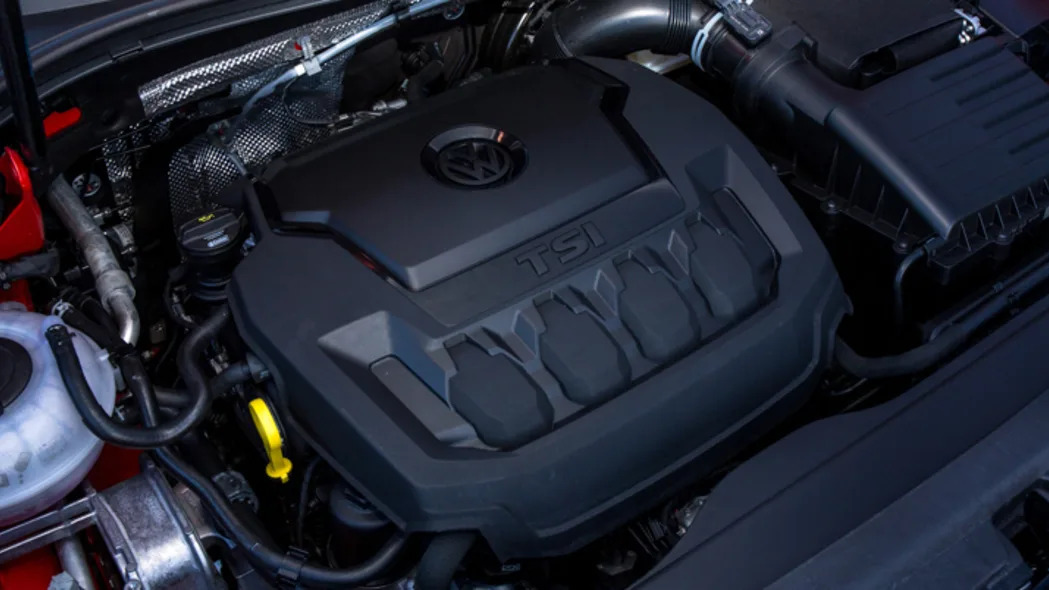
We only get the gasoline 2.0-liter turbo-four (for now).
Europe gets eight different powertrain options. Eight. There are four gasoline and four diesel combinations, each powered by four-cylinder, turbocharged engines. European cars also use a seven-speed, dual-clutch transmission, or a six-speed manual with the base, diesel engine. None of this will be coming to the US.
When our car launches, it'll only be powered by a gasoline 2.0-liter turbo-four. But it's not the one you're familiar with right now – it'll be an updated version, so consider it a mid-cycle refresh. Our 2.0T will have 184 horsepower (the torque number is still being finalized) and will be mated to an all-new eight-speed automatic transmission from Aisin. Volkswagen says its US customers prefer conventional automatics for non-sporty cars; DSGs will only be used for more performance-oriented vehicles (read: not the Tiguan). And don't even think about a manual transmission.
There's a plug-in hybrid GTE model coming to Europe, too, but it's still unclear if this powertrain will make its way Stateside. We can always hold out hope for the diesel, but, well, you know.
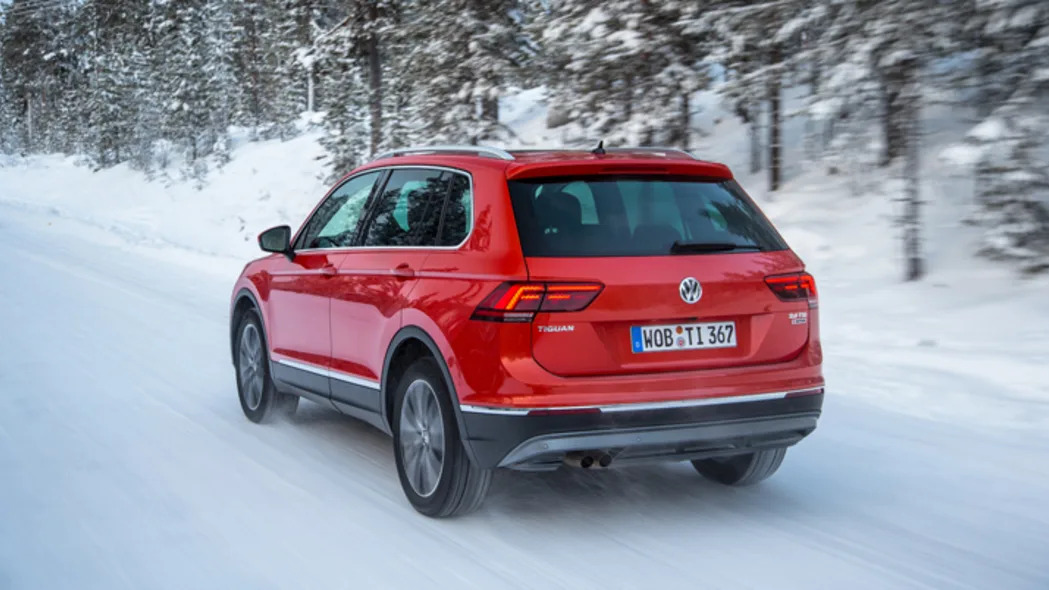
It's nice to drive.
Volkswagen put us in a Tiguan with the 177-hp version of the 2.0-liter TSI turbo-four and the seven-speed DSG. (Funny thing: European media were given diesel models to test, but we Americans weren't allowed anywhere near those cars – go figure.) Overall, the Tig is pleasant, with enough power to get it moving and a transmission that's eager to downshift or hold you in the right gear for maximum power. The European Tiguan gets Volkswagen's progressive steering system, which feels decidedly light, especially on center. In fact, there isn't a lot of communication through the wheel at all. Thankfully, the suspension is really nicely tuned – you'll get a better sense of what's happening on the road via your butt than your hands.
But we won't get Dynamic Chassis Control.
European cars will get the progressive steering gear because these models will also be fitted with another not-for-US option: Dynamic Chassis Control. It's the same system offered on the Golf R, or the GTI with the Performance Pack, which allows you to toggle between several drive modes: Eco, Comfort, Normal, Sport, and Individual. You move through these modes by pushing the 4Motion Active Control dial when it's set to Onroad mode, toggling between them, and adjusting the Individual settings through the infotainment touchscreen.
In Normal Onroad mode, the Tiguan rides perfectly well. It's not floaty or soft, but not overly firm or sporty, either. We didn't notice much change after toggling the DCC over to Sport mode, except that the steering felt slightly heavier just off center. But we like the different levels of driver customization. It's unclear exactly how the US-spec Tiguan will be set up.
It's great in the snow, but not for hooligans.
The vast majority of our drive in and around Arvidsjaur was spent on snow and ice. And we're not just talking about occasional frozen patches – we spent a couple hours on an actual snow-covered frozen lake. For best results, Volkswagen fitted our Tiguan with 235/50R19 ContiVikingContact (Viking!) snow tires, and combined with the different 4Motion systems, the Tiguan was immensely surefooted in on slippery roads.
A little too surefooted, actually. Don't get us wrong, actual customers will greatly enjoy how the various 4Motion Active Control modes function, especially Snow mode, where it's damn near impossible to get the Tiguan to act up. The Snow setting flattens throttle response, so it's never punchy, and the moment the system detects slip while cornering, it brakes the correct wheel(s) to keep things stable. It works like a charm.
But selfishly, we were on an empty track carved out on a frozen lake (the same place where we tested the Golf R in 2014) and felt like ditching the safety nannies for a while. Here, with the DCC and stability control set to Sport, there was enough control to get the back end to come around while turning, but the system defaults to just cutting power, braking, and thus, understeer. Good for times when you're actually commuting through snow, bad for parking lot donuts. C'est la vie.

The premium interior remains.
One of the major selling points for the old Tiguan was its premium-feeling interior. But now that nearly everything else in the small crossover segment has stepped up its game, it's going to take more than some nice plastics and an occasional leather-wrapped bulge to set the Tiguan apart. Thankfully, the new interior is really a nice step up from the old car – it honestly feels more premium than the (albeit aging) cabin in the Audi Q3.
The leather seats are comfortable and supportive. All of the interior controls are logically organized, and even the smallest buttons and knobs have a solid feel to them. While driving over rough roads in Sweden, our snow-tire-equipped Tiguan was nicely hushed inside. The Tiguan's interior is easily the nicest in its class. And it's not just nicer in the way a Golf interior is better than a Ford Focus. It's even better than that.
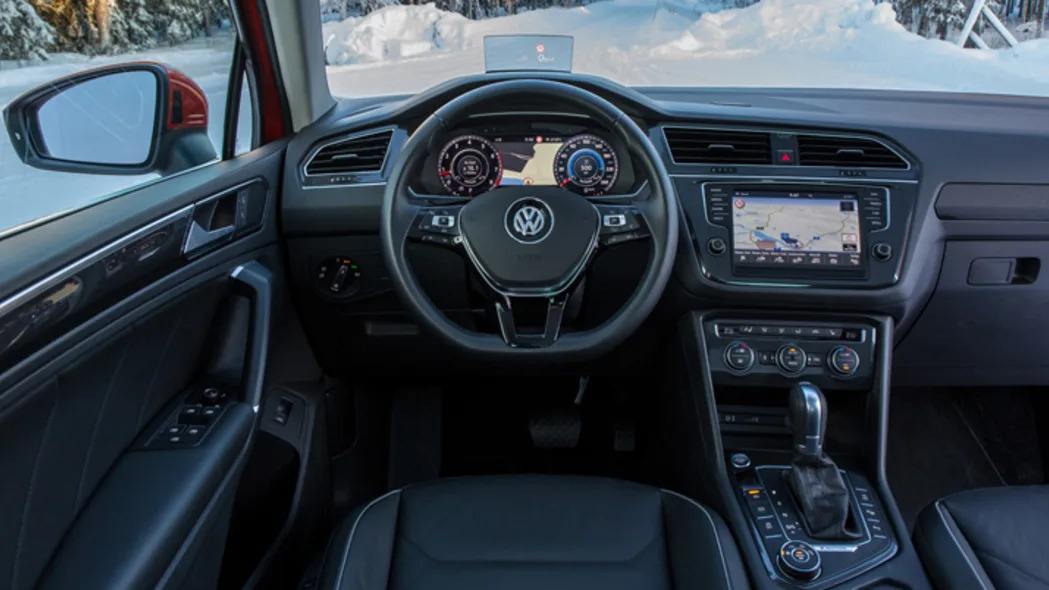
We might miss out on some cool tech.
Volkswagen will offer the Euro-spec Tiguan with a fully digital instrument panel. Think of it as a less-robust version of Audi's Virtual Cockpit. The speedometer and tachometer flank either side of the display, with a map or other vital information in between. It looks seriously sharp, and we want it.
But it might not be offered Stateside. This is one of many things still being worked out for the US-spec Tiguan – Volkswagen isn't sure whether or not it wants to offer the display as a high-end option, or at all. The other unknown has to do with the infotainment system. European models will launch with the company's MIB II platform that we're already familiar with, but Volkswagen is considering installing the new, gesture control-equipped infotainment system previewed in the e-Golf Touch concept from this year's Consumer Electronics Show. Since the facelifted Golf will launch before the Tiguan, it might make sense to offer it in both the compact hatch and its taller crossover sibling. But that's still up in the air.
One final thing: Look closely and you'll see a small head-up display mounted above the gauge cluster. It's a plastic, pop-up unit not unlike what's found in the Mazda3. It offers clear, legible information about speed and navigation. And it's not coming to the US. Bummer.

We'll (kind of) see our Tiguan in Paris.
The long-wheelbase, three-row Tiguan will make its world debut at the Paris Motor Show later this year, and North American production will kick off at Volkswagen's plant in Mexico in the first half of 2017. Of course, being a Paris debut, the longer Tiguan will likely be shown in proper Euro-spec, so don't expect the final, official, US-spec car to show its face until sometime in 2017. Volkswagen's also planning to show its new midsize crossover around the end of 2016 or early 2017, and don't be surprised if that vehicle is revealed before the Tiguan goes on sale.
It's still a long way away, but the Tiguan is something to look forward to. Our time with this Euro-spec model reveals a more mainstream-focused offering than before that still checks the boxes of being entertaining to drive, functional, and genuinely upscale inside. We'll see if all that holds true for the US car when we finally get to drive our version next year.
Ten bucks says you (probably) can't pick out Arvidsjaur on a map. But if you're a car buff – and Autoblog reader – you've undoubtedly seen pictures of this place without even knowing it. All those spy shots of European test mules and prototypes in the snow? Most of them are from in and around Arvidsjaur. Many car companies have winter driving schools up here – Volkswagen included. So despite the bitterly cold temperatures, this tiny town in northern Sweden is a hotbed for wintertime development. And since a big feature of the new Tiguan is its improved 4Motion all-wheel-drive system with an Active Control function, what better place to get a sense of its snow prowess than the very place where these systems are developed?
Now, because the US-spec Tiguan is so far away, the car we drove is extremely dissimilar to the final product that will end up on our shores. So rather than just tell you what the not-for-US Tiguan is like to drive, we're instead bringing you some details of what to expect for our upcoming new model, with the snowy roads of Sweden as a backdrop and some Euro-spec impressions spliced in. It may be over a year away, but we've got a good idea of what to expect for America's next Tiguan.

Our version will be longer, with an optional third row of seats.
Like the looks of the Tiguan pictured here? Well, don't get too attached. The US-spec model will be longer, riding on a stretched wheelbase – final dimensions are still being confirmed. Volkswagen isn't just making our Tiguan longer for no good reason. In an effort to maximize versatility and functionality, the Tiguan will be offered with three rows of seats in the US. That said, way-back seating will be an option, so if you'd rather just have a Tiguan with a huge cargo area, Volkswagen will happily sell you one. Euro-spec Tiguans offer 58.5 cubic feet of space with the rear seats folded, and the US market car will be even more capacious.
The long-wheelbase, three-row model will be sold in Europe along the shorter, five-passenger model you see here. Plus, the car pictured here has the European "off-road" front end treatment, something we won't be getting in the States. Instead, expect our Tiguan to have a more squared-off fascia appearance, similar to what we saw in Frankfurt last year. As for the possibility of getting either the short-wheelbase Tiguan or its rugged front fascia in the States, Volkswagen says neither is likely.

There's a new 4Motion Active Control system.
4Motion all-wheel drive isn't new, but it gets a few new tricks in the Tiguan. Since it rides on the same versatile MQB architecture as the Golf, the Tiguan gets the same fifth-generation, multi-plate-clutched Haldex system as the Golf R. This means when all-wheel-drive power isn't needed, the rear axle can be decoupled for better efficiency. But that's old news in Volkswagen's world. What's brand-new for the Tiguan is something called 4Motion Active Control, with a rotary dial on the center console, just behind the gear lever, that lets drivers toggle between different drive modes.
Active Control isn't a new concept – think of it as a less-robust version of Land Rover's Terrain Management system. All 4Motion-equipped Tiguans will get this – you can switch between Onroad, Snow, Offroad, and Offroad Individual settings, which alter the different drive systems for better performance in different conditions. We'll go into more detail shortly.

We only get the gasoline 2.0-liter turbo-four (for now).
Europe gets eight different powertrain options. Eight. There are four gasoline and four diesel combinations, each powered by four-cylinder, turbocharged engines. European cars also use a seven-speed, dual-clutch transmission, or a six-speed manual with the base, diesel engine. None of this will be coming to the US.
When our car launches, it'll only be powered by a gasoline 2.0-liter turbo-four. But it's not the one you're familiar with right now – it'll be an updated version, so consider it a mid-cycle refresh. Our 2.0T will have 184 horsepower (the torque number is still being finalized) and will be mated to an all-new eight-speed automatic transmission from Aisin. Volkswagen says its US customers prefer conventional automatics for non-sporty cars; DSGs will only be used for more performance-oriented vehicles (read: not the Tiguan). And don't even think about a manual transmission.
There's a plug-in hybrid GTE model coming to Europe, too, but it's still unclear if this powertrain will make its way Stateside. We can always hold out hope for the diesel, but, well, you know.

It's nice to drive.
Volkswagen put us in a Tiguan with the 177-hp version of the 2.0-liter TSI turbo-four and the seven-speed DSG. (Funny thing: European media were given diesel models to test, but we Americans weren't allowed anywhere near those cars – go figure.) Overall, the Tig is pleasant, with enough power to get it moving and a transmission that's eager to downshift or hold you in the right gear for maximum power. The European Tiguan gets Volkswagen's progressive steering system, which feels decidedly light, especially on center. In fact, there isn't a lot of communication through the wheel at all. Thankfully, the suspension is really nicely tuned – you'll get a better sense of what's happening on the road via your butt than your hands.
But we won't get Dynamic Chassis Control.
European cars will get the progressive steering gear because these models will also be fitted with another not-for-US option: Dynamic Chassis Control. It's the same system offered on the Golf R, or the GTI with the Performance Pack, which allows you to toggle between several drive modes: Eco, Comfort, Normal, Sport, and Individual. You move through these modes by pushing the 4Motion Active Control dial when it's set to Onroad mode, toggling between them, and adjusting the Individual settings through the infotainment touchscreen.
In Normal Onroad mode, the Tiguan rides perfectly well. It's not floaty or soft, but not overly firm or sporty, either. We didn't notice much change after toggling the DCC over to Sport mode, except that the steering felt slightly heavier just off center. But we like the different levels of driver customization. It's unclear exactly how the US-spec Tiguan will be set up.
It's great in the snow, but not for hooligans.
The vast majority of our drive in and around Arvidsjaur was spent on snow and ice. And we're not just talking about occasional frozen patches – we spent a couple hours on an actual snow-covered frozen lake. For best results, Volkswagen fitted our Tiguan with 235/50R19 ContiVikingContact (Viking!) snow tires, and combined with the different 4Motion systems, the Tiguan was immensely surefooted in on slippery roads.
A little too surefooted, actually. Don't get us wrong, actual customers will greatly enjoy how the various 4Motion Active Control modes function, especially Snow mode, where it's damn near impossible to get the Tiguan to act up. The Snow setting flattens throttle response, so it's never punchy, and the moment the system detects slip while cornering, it brakes the correct wheel(s) to keep things stable. It works like a charm.
But selfishly, we were on an empty track carved out on a frozen lake (the same place where we tested the Golf R in 2014) and felt like ditching the safety nannies for a while. Here, with the DCC and stability control set to Sport, there was enough control to get the back end to come around while turning, but the system defaults to just cutting power, braking, and thus, understeer. Good for times when you're actually commuting through snow, bad for parking lot donuts. C'est la vie.

The premium interior remains.
One of the major selling points for the old Tiguan was its premium-feeling interior. But now that nearly everything else in the small crossover segment has stepped up its game, it's going to take more than some nice plastics and an occasional leather-wrapped bulge to set the Tiguan apart. Thankfully, the new interior is really a nice step up from the old car – it honestly feels more premium than the (albeit aging) cabin in the Audi Q3.
The leather seats are comfortable and supportive. All of the interior controls are logically organized, and even the smallest buttons and knobs have a solid feel to them. While driving over rough roads in Sweden, our snow-tire-equipped Tiguan was nicely hushed inside. The Tiguan's interior is easily the nicest in its class. And it's not just nicer in the way a Golf interior is better than a Ford Focus. It's even better than that.

We might miss out on some cool tech.
Volkswagen will offer the Euro-spec Tiguan with a fully digital instrument panel. Think of it as a less-robust version of Audi's Virtual Cockpit. The speedometer and tachometer flank either side of the display, with a map or other vital information in between. It looks seriously sharp, and we want it.
But it might not be offered Stateside. This is one of many things still being worked out for the US-spec Tiguan – Volkswagen isn't sure whether or not it wants to offer the display as a high-end option, or at all. The other unknown has to do with the infotainment system. European models will launch with the company's MIB II platform that we're already familiar with, but Volkswagen is considering installing the new, gesture control-equipped infotainment system previewed in the e-Golf Touch concept from this year's Consumer Electronics Show. Since the facelifted Golf will launch before the Tiguan, it might make sense to offer it in both the compact hatch and its taller crossover sibling. But that's still up in the air.
One final thing: Look closely and you'll see a small head-up display mounted above the gauge cluster. It's a plastic, pop-up unit not unlike what's found in the Mazda3. It offers clear, legible information about speed and navigation. And it's not coming to the US. Bummer.

We'll (kind of) see our Tiguan in Paris.
The long-wheelbase, three-row Tiguan will make its world debut at the Paris Motor Show later this year, and North American production will kick off at Volkswagen's plant in Mexico in the first half of 2017. Of course, being a Paris debut, the longer Tiguan will likely be shown in proper Euro-spec, so don't expect the final, official, US-spec car to show its face until sometime in 2017. Volkswagen's also planning to show its new midsize crossover around the end of 2016 or early 2017, and don't be surprised if that vehicle is revealed before the Tiguan goes on sale.
It's still a long way away, but the Tiguan is something to look forward to. Our time with this Euro-spec model reveals a more mainstream-focused offering than before that still checks the boxes of being entertaining to drive, functional, and genuinely upscale inside. We'll see if all that holds true for the US car when we finally get to drive our version next year.
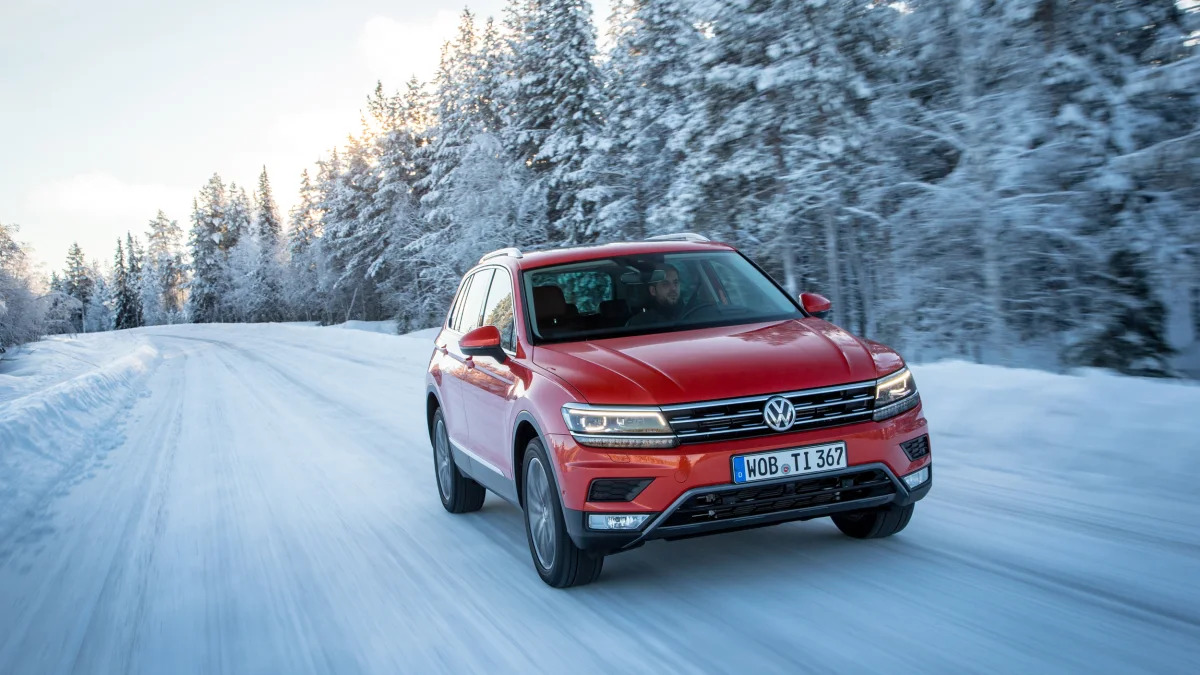








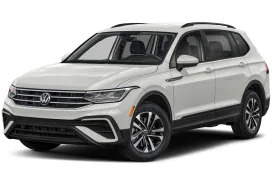



Sign in to post
Please sign in to leave a comment.
Continue